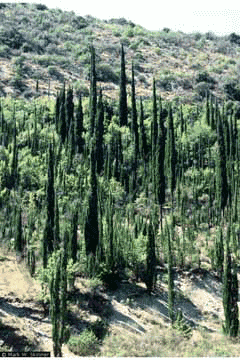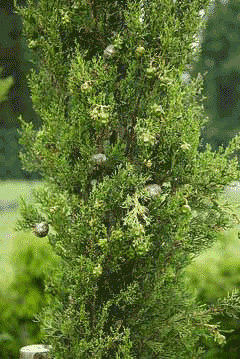 |
|
Mark W. Skinner @ USDA-NRCS PLANTS Database |
 |
|
Translate this page:
Summary
Form: Columnar.
Physical Characteristics

 Cupressus sempervirens is an evergreen Tree growing to 30 m (98ft) by 5 m (16ft) at a medium rate.
Cupressus sempervirens is an evergreen Tree growing to 30 m (98ft) by 5 m (16ft) at a medium rate.
See above for USDA hardiness. It is hardy to UK zone 7. It is in leaf all year, in flower from January to February. The species is monoecious (individual flowers are either male or female, but both sexes can be found on the same plant) and is pollinated by Wind.
Suitable for: light (sandy), medium (loamy) and heavy (clay) soils, prefers well-drained soil and can grow in nutritionally poor soil. Suitable pH: mildly acid, neutral and basic (mildly alkaline) soils. It cannot grow in the shade. It prefers dry or moist soil and can tolerate drought.
UK Hardiness Map
US Hardiness Map
Synonyms
Plant Habitats
Woodland Garden Canopy;
Edible Uses
References More on Edible Uses
Medicinal Uses
Plants For A Future can not take any responsibility for any adverse effects from the use of plants. Always seek advice from a professional before using a plant medicinally.
Anthelmintic Antipyretic Antirheumatic Antiseptic Aromatherapy Astringent Balsamic Vasoconstrictor
Vulnerary
The cones and young branches are anthelmintic, antipyretic, antirheumatic, antiseptic, astringent, balsamic and vasoconstrictive[7, 46, 240]. They are harvested in late winter and early spring, then dried for later use[7]. Taken internally, it is used in the treatment of whooping cough, the spitting up of blood, spasmodic coughs, colds, flu and sore throats[254]. Applied externally as a lotion or as a diluted essential oil (using an oil such as almond), it astringes varicose veins and haemorrhoids, tightening up the blood vessels[254]. A foot bath of the cones is used to cleanse the feet and counter excessive sweating[254]. The extracted essential oil should not be taken internally without professional guidance[254]. A resin is obtained from the tree by making incisions in the trunk[7]. This has a vulnerary action on slow-healing wounds and also encourages whitlows to come to a head[7]. An essential oil from the leaves and cones is used in aromatherapy. Its keyword is 'Astringent'[210].
References More on Medicinal Uses
The Bookshop: Edible Plant Books
Our Latest books on Perennial Plants For Food Forests and Permaculture Gardens in paperback or digital formats.

Edible Tropical Plants
Food Forest Plants for Hotter Conditions: 250+ Plants For Tropical Food Forests & Permaculture Gardens.
More

Edible Temperate Plants
Plants for Your Food Forest: 500 Plants for Temperate Food Forests & Permaculture Gardens.
More

More Books
PFAF have eight books available in paperback and digital formats. Browse the shop for more information.
Shop Now
Other Uses
Cosmetic Essential Wood
An essential oil is distilled from the shoots. It is used in perfumery and soap making[1, 46, 61]. The leaves contain about 2% essential oil whilst the wood contains about 2.5%[240]. An infusion of the wood is used in footbaths to combat perspiration of the feet[7]. Wood - fragrant, very hard and durable. A popular wood for building uses, cabinet making and wardrobes, especially since it retains its fragrance, repels moths and is impervious to woodworm[1, 7, 11, 89].
Special Uses
Scented Plants
References More on Other Uses
Cultivation details
Landscape Uses:Border, Screen, Specimen. Thrives in a deep well-drained loamy or peaty soil[11]. Established plants are very tolerant of hot dry conditions and drought[81]. Tolerates poor sandy soils[81] but is then more subject to damage by white-scale insects in a succession of dry seasons[11]. Plants are not very happy when growing on chalky soils but they thrive on limestone[200]. Requires a sunny position[81]. This species is somewhat tender in Britain especially when young and at least in the north of the country[81], it grows best in the south and the west[11]. Trees are probably much hardier than has been supposed. No trees were reported as killed by the very severe winter of 1962 - 3, even some trees east of Edinburgh survived without damage. A healthy tree at Cambridge botanical gardens was 6 metres tall in 1989[K]. Growth can be quite vigorous, especially in young trees, with many averaging 60cm a year[185]. Growth slows and almost comes to a halt when the tree is 12 - 15 metres tall[185]. New growth takes place from mid-May to mid-October[185]. Plants are subject to injury by the wind[1, 11]. Trees are notably susceptible to honey fungus[200]. The seed takes two summers to mature[227]. Mature cones can remain unopened on the tree for a number of years[81]. They open after the heat of a forest fire to scatter their seeds which then germinate and grow away quickly in the ashes of the fire[200]. Plants are resentful of root disturbance, any transplanting should be done in April or September when the roots are in active growth[11, 81]. A very variable plant[11]. Special Features:Not North American native, Inconspicuous flowers or blooms.
References Carbon Farming Information and Carbon Sequestration Information
Temperature Converter
Type a value in the Celsius field to convert the value to Fahrenheit:
Fahrenheit:
The PFAF Bookshop
Plants For A Future have a number of books available in paperback and digital form. Book titles include Edible Plants, Edible Perennials, Edible Trees,Edible Shrubs, Woodland Gardening, and Temperate Food Forest Plants. Our new book is Food Forest Plants For Hotter Conditions (Tropical and Sub-Tropical).
Shop Now
Plant Propagation
Seed - sow late winter in a cold frame and only just cover the seed[164]. Three weeks cold stratification can improve germination rates[164]. The seed usually germinates in 1 - 2 months at 20°c. The seedlings are very subject to damping off so should be watered with care and kept well-ventilated[113]. When they are large enough to handle, prick the seedlings out into individual pots and grow them on in the greenhouse for at least their first winter. Plant them out into their permanent positions in late spring or early summer, after the last expected frosts. The seed can store for several years[113]. Cuttings of almost ripe wood, September in a frost-proof frame[1]. April/May is the best time to take cuttings[113].
Other Names
If available other names are mentioned here
Native Range
TEMPERATE ASIA: Cyprus, Iran (north), Israel, Jordan, Lebanon, Syria, Turkey (south) EUROPE: Greece (Kríti) AFRICA: Libya
Weed Potential
Right plant wrong place. We are currently updating this section.
Please note that a plant may be invasive in one area but may not in your area so it's worth checking.
Conservation Status
IUCN Red List of Threatened Plants Status :

Growth: S = slow M = medium F = fast. Soil: L = light (sandy) M = medium H = heavy (clay). pH: A = acid N = neutral B = basic (alkaline). Shade: F = full shade S = semi-shade N = no shade. Moisture: D = dry M = Moist We = wet Wa = water.
Now available:
Food Forest Plants for Mediterranean Conditions
350+ Perennial Plants For Mediterranean and Drier Food Forests and Permaculture Gardens.
[Paperback and eBook]
This is the third in Plants For A Future's series of plant guides for food forests tailored to
specific climate zones. Following volumes on temperate and tropical ecosystems, this book focuses
on species suited to Mediterranean conditions—regions with hot, dry summers and cool, wet winters,
often facing the added challenge of climate change.
Read More
Expert comment
Author
L.
Botanical References
1150200
Links / References
For a list of references used on this page please go here
Readers comment